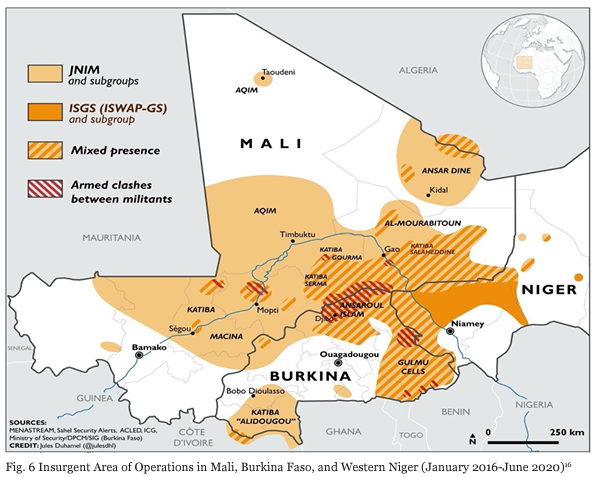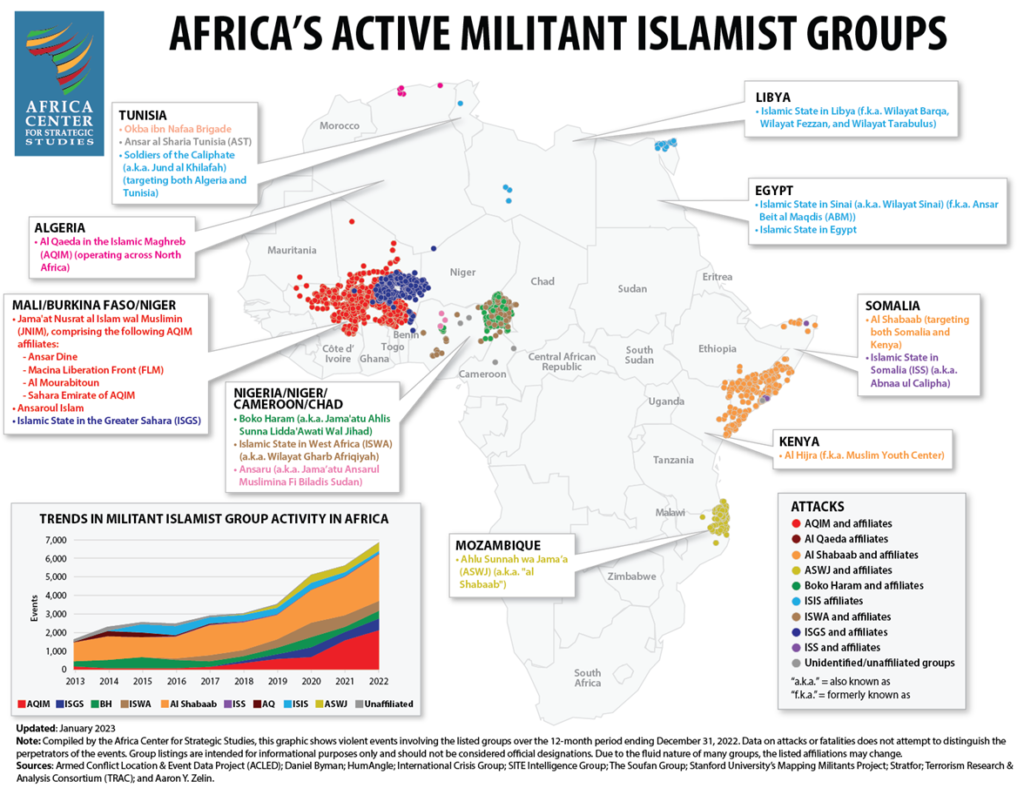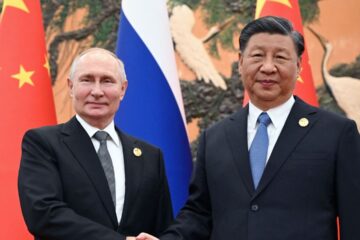AL-QAEDA and DAESH in Africa
What you want to understand… 🤔
- How different are al-Qaeda and Daesh’s targets, strategies and image in Africa?
- What other African jihadist groups collaborate with these two main organisations?
- What are al-Qaeda and Daesh respective territorial possessions and ambitions?
- How is the terrorist threat in Africa expected to evolve in the short- and medium-term?
- Why is al-Qaeda considered as the most powerful group in Africa and Daesh as the most visible?
I. Two opposed groups with a same objective
A. Same ideology: salafi jihadism
Salafi jihadist groups resort to violent means in order to seize power and establish a caliphate where people would live according to Allah’s law, the shari’ah.
Al-Qaeda and Daesh‘s enemy is the Western world and all those who collaborate with it.
For more info on radical Islamist currents, read my article on Religious communities in the Middle East !
These terrorist jihadist groups thrive among poor communities where the youth lacks perspectives and challenges the established order. They also play on inter-ethnic and inter-community tensions. Some Africans may also join al-Qaeda and Daesh because they are victim of violence from state forces.
Jihadist groups’ narrative to seduce new recruits revolves around the opportunity to make financial gains and improve one’s social status. New recruits will also be able to protect their communities and bring order in territories abandoned by state authorities.
B. Different targets
On the one hand, al-Qaeda focuses on a “far enemy” i.e. the Western world and its partners.
On the other hand, Daesh directs its efforts against a “near enemy” i.e. Muslims who don’t respect the shari’ah. It wants to cleanse Islam by being hostile towards them and excommunicating them.
C. Different approaches
Al-Qaeda seeks popularity and public figures’ support so as to insinuate itself into local communities.
On the contrary, Daesh exploits local insurrections and resorts to violence and criminal networks in order to expand its influence in Africa.
D. Different images and communication strategies
Al-Qaeda has the image of a long-standing and elitist jihadist group whose claims may come across as abstract. However, it enjoys a certain legitimacy thanks to its historical role in Afghanistan.
Daesh heavily uses social media and gives much importance to publicising its actions worldwide. This strategy ensures a better recruitment and fanaticisation of young people despite the “near enemy” logic that may deter some from joining the group. By bringing much light on itself, Daesh increases its number of enemies. Al-Qaeda made the mistake in 2001 and bore the cost of it in Afghanistan.
II. Al-Qaeda in Africa: the most dangerous group
Al-Qaeda enjoys a relative popularity in Africa as it proposes a political alternative that challenges the established order. Its regional branches adapt their approach to the specificities of the territories on which they fight. Al-Qaeda strongholds are the Sahel region and Somalia. It endeavours to expand to the Gulf of Guinea and Eastern Africa.
Al-Qaeda is the most dangerous group in Africa as it has more fighters, equipment and financial means to achieve its goals than Daesh. It is also the one that manages to insinuate into local communities, thus becoming more difficult to identify and fight.
A. In the Sahel region

Jama’a Nusrat al-Islam wa al-Muslimin (JNIM) is al-Qaeda’s branch in the Sahel region. It emerged in 2017 as a fusion between al-Qaeda in the Islamic Maghreb (AQIM) and other regional jihadist groups such as the Malian group of Iyad Ag Ghaly named Ansar Dine.
If in the news or elsewhere you come across the following organisation names, then bear in mind that they all belong more or less to JNIM: AQIM, Ansar Dine, Katiba Macina, Katiba Gourma, al Mourabitoune, Tombouctou Emirate, Ansarul Islam, the group of Bolé, the group of Abou Hanifa and the group of Arly.

1. Mali
Central and Northern Mali can be considered as JNIM’s sanctuary. Governmental forces are absent/passive in this region, in particular in the North that is under Tuaregs‘s control.
Besides, exactions committed by the Wagner group and Malian armed forces, especially against Fula people, directly benefit JNIM’s recruiting strategy in the region.
Short- and medium-term perspectives:
- Multiplication of coordinated attacks towards the South and the capital city, Bamako
- Expansion of JNIM due to the Wagner group and Malian forces’ inability to contain it. The UN Mission in Mali (MINUSMA) is isolated after France’s departure and nothing can actually be expected from it
- Potential destabilisation of the Malian junta by a popular movement denouncing the degradation of the political, economic and security situation
2. Niger
In Niger, structural weaknesses of the army and a lack of cooperation with Burkina Faso facilitate JNIM’s operations in the 3-frontier region (Mali, Niger and Burkina Faso). Moreover, Nigerien terrorist groups benefit from the expertise and equipment shared by those fighting in Mali.
3. Burkina Faso
JNIM regularly enters Burkina Faso’s territory from Mali with two objectives in mind:
- Securing trafficking routes from the Ivory Coast
- Expanding its influence to the Gulf of Guinea through Benin and Togo
B. In the Gulf of Guinea

1. Nigeria
Ansaru is al-Qaeda’s branch in Nigeria. It was originally a faction of Boko Haram, another Nigerian terrorist group, from which it split in 2012. However, since 2015, the group is mostly inactive but some of its members can be found in North-West Nigeria.
2. Ivory Coast
Terrorist armed groups keep on pushing at the North of the Ivory Coast along the frontier with Burkina Faso. Furthermore, as mentioned earlier, they aim to develop trafficking routes that connect the Gulf of Guinea to the Maghreb through the Sahel-Sahara region.
3. Benin
In Benin, authorities do not manage to establish a close cooperation with Burkina Faso which hampers efforts to counter terrorist groups’ advance. Nevertheless, Benin shares intelligence with Niger and they conduct joint operations along their common border.
4. Togo
Togo represents an important recruiting ground for al-Qaeda and other jihadist groups. As a matter of fact, the country’s situation makes its population susceptible to join jihadist groups:
- Lots of illegal trafficking
- Refugees seeking to improve their condition
- Vulnerable communities practicing transhumance
- Fula people being stigmatised
- A weak State unable to face terrorism alone
C. In the Horne of Africa (Somalia)

In Somalia, al-Qaeda can rely on Harakat al Shabaab al Moudjahidin aka al-Shabaab and its 10,000 to 12,000 fighters. The group is at the forefront of al-Qaeda’s communication strategy thanks to its regular and bloody attacks in Somalia, Kenya and Ethiopia.
Short- and medium-term perspectives:
- Reinforcement of al-Shabaab’s stronghold in Somalia because of State’s weaknesses, local corruption and weapons smuggled from Yemen
- Risk of establishment in the mountainous region of central Ethiopia
For more info on the situation in Somalia and how al-Shabaab destabilises the country and Eastern Africa in general, read my article Somalia: al-Qaeda’s base in Eastern Africa !
III. Daesh in Africa: the most visible group
Daesh relies on a network of autonomous wilayahs (provinces) that adapt their strategies to local circumstances so as to better target the youth. However, violence remains at the core of their approach in Africa. Daesh strongholds are the Sahel region (Liptako-Gourma), Nigeria, Mozambique and the Democratic Republic of Congo. Its objective is to embed its ideology in African minds and draw attention onto Africa away from the Middle East where its leaders are chased down.
As mentioned at the beginning of this article, Daesh is the group that enjoys the most visibility worldwide thanks to its use of modern means of communication. Moreover, it concentrates its efforts on few major attacks that can bring always more visibility to its ideology and activities. Nonetheless, its African implantation remains inferior to that of al-Qaeda. In fact, Daesh doesn’t possess the same means of action and its violent and exclusive approach may impede its popularity at grassroot levels.
A. In the Sahel region
The Islamic State Sahel Province (ISSP), formerly the Islamic State in the Greater Sahara (ISGS), mainly recruits among Fula people that are being stigmatised by Tuaregs in Northern Mali.
The ISSP seeks to expand its territorial possessions in the Liptako-Gourma region and the North of Mali and as a consequence regularly clashes with al-Qaeda’s JNIM.

Short-term perspectives:
- Re-establishment of a sanctuary in the Malian part of the Liptako-Gourma region from Niger in order to avoid French forces still active in Niger
- More attacks against Malian armed forces, local community militia and isolated towns and villages
B. In the Gulf of Guinea (Nigeria)
The Islamic State West Africa Province (ISWAP) is Daesh‘s most powerful wilayah in Africa and thus its showcase on social media.
As a matter of fact, this branch was a faction of Boko Haram that split up between 2014 and 2016. It was due to disagreements on the treatment of Muslim civilians (Boko Haram being too violent against them).
The ISWAP’s 3,000 jihadists mainly fight in the North-East of Nigeria in humid areas near Lake Chad.

C. Central and Eastern Africa
Daesh has been able to grow in this region as it could fill in the void left by failed States. Moreover, some Muslim minorities are stigmatised in this part of Africa. Therefore, Daesh has established itself there by using to its advantage inter-religious and inter-ethnic tensions.
We can expect terrorism in Central and Eastern Africa to take more and more importance in the coming years. Indeed, jihadist activities in the Democratic Republic of Congo and Mozambique will probably spread to neighbouring countries and wherever conditions are reunited for their implementation.
1. Democratic Republic of Congo (DRC)
The Islamic State Central Africa Province (ISCAP) is Daesh‘s branch in DRC. It benefits from the support of another group, Madinat Tawhid wal muwahidin, which is locally known as the Allied Democratic Forces and that pledged allegiance in 2017.
Additionally, we can observe a regionalisation of the jihadist threat as semi-autonomous factions emerge in Uganda, Rwanda, Burundi and Tanzania.
2. Mozambique
Daesh‘s branch in Mozambique is Ansar al Sunnah aka Islamic State in Mozambique (ISM). It is active since 2017 in the North of Mozambique (Cabo Delgado) as well as in Tanzania.
Northern Mozambique represents a sanctuary from which the group carries out attacks in the South.
Ansar al Sunnah’s current objective is to recover its material capacities that it lost during the military intervention of Rwandan forces in 2021.
It finances itself by trading wood and imposing taxes on economic activities in areas under its control.





6 Comments
TRANSITIONAL JUSTICE and TERRORISM in Africa and the Middle East – geopol-trotters · 11 May 2025 at 12:14 pm
[…] victim or both at the same time? This question is a core difficulty faced by societies in Sub-Saharan Africa and the Middle East when dealing with people affected by terrorism. In order to tackle terrorism, […]
Weak and Failed States in Africa – geopol-trotters · 26 April 2023 at 2:42 pm
[…] a context where terrorist groups seek to expand to the Gulf of Guinea, parks W, Arly and Pendjari have become sanctuaries for them. Group Arly and group Abou Hanifa are […]
THE DEMOCRATIC REPUBLIC OF CONGO: the resource curse - geopol-trotters · 31 March 2023 at 7:54 am
[…] and split in many small factions. As it was losing momentum, it gave its oath of allegiance to the Islamic State Central Africa Province (ISCAP) in 2017. It then became the Madinat Tawhid wal muwahidin but is still mostly referred to as ADF. […]
UGANDA: the “Pearl of Africa” - geopol-trotters · 31 March 2023 at 7:33 am
[…] in many small factions. As the movement was losing momentum, it gave its oath of allegiance to the Islamic State Central Africa Province (ISCAP) in 2017. It then became the Madinat Tawhid wal muwahidin but is still referred to as ADF by most […]
Pan-Africanism, between genuine aspirations and ideological hijacking - geopol-trotters · 18 March 2023 at 12:27 pm
[…] the collective effort initiated by the G5 Sahel in conjunction with the French operation Barkhane. Terrorist groups are now progressively pushing towards the Gulf of Guinea, eventually threatening these countries that have stood back for years and left the burden of […]
Jihadism in Mali, the Fula case - geopol-trotters · 3 March 2023 at 7:36 pm
[…] image among Bambara and Dogon populations. In 2016, it became the Katiba Macina and joined the JNIM, a sort of conglomerate of al Qaeda terrorist groups in the […]